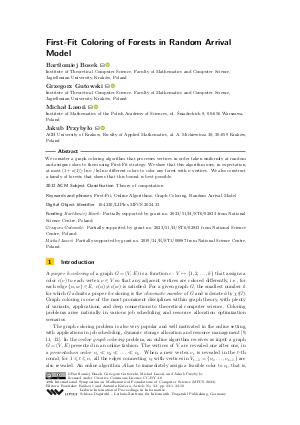First-Fit Coloring of Forests in Random Arrival Model
Authors
Bartłomiej Bosek  ,
Grzegorz Gutowski
,
Grzegorz Gutowski  ,
Michał Lasoń
,
Michał Lasoń  ,
Jakub Przybyło
,
Jakub Przybyło 
-
Part of:
Volume:
49th International Symposium on Mathematical Foundations of Computer Science (MFCS 2024)
Part of: Series: Leibniz International Proceedings in Informatics (LIPIcs)
Part of: Conference: Mathematical Foundations of Computer Science (MFCS) - License:
 Creative Commons Attribution 4.0 International license
Creative Commons Attribution 4.0 International license
- Publication Date: 2024-08-23
File

PDF
LIPIcs.MFCS.2024.33.pdf
- Filesize: 0.64 MB
- 10 pages
Document Identifiers
Subject Classification
ACM Subject Classification
- Theory of computation
Keywords
- First-Fit
- Online Algorithms
- Graph Coloring
- Random Arrival Model
Metrics
- Access Statistics
-
Total Accesses (updated on a weekly basis)
0PDF Downloads0Metadata Views
Abstract
We consider a graph coloring algorithm that processes vertices in order taken uniformly at random and assigns colors to them using First-Fit strategy. We show that this algorithm uses, in expectation, at most (1+o(1))⋅ln n / ln ln n different colors to color any forest with n vertices. We also construct a family of forests that shows that this bound is best possible.
Cite As Get BibTex
Bartłomiej Bosek, Grzegorz Gutowski, Michał Lasoń, and Jakub Przybyło. First-Fit Coloring of Forests in Random Arrival Model. In 49th International Symposium on Mathematical Foundations of Computer Science (MFCS 2024). Leibniz International Proceedings in Informatics (LIPIcs), Volume 306, pp. 33:1-33:10, Schloss Dagstuhl – Leibniz-Zentrum für Informatik (2024)
https://doi.org/10.4230/LIPIcs.MFCS.2024.33
BibTex
@InProceedings{bosek_et_al:LIPIcs.MFCS.2024.33,
author = {Bosek, Bart{\l}omiej and Gutowski, Grzegorz and Laso\'{n}, Micha{\l} and Przyby{\l}o, Jakub},
title = {{First-Fit Coloring of Forests in Random Arrival Model}},
booktitle = {49th International Symposium on Mathematical Foundations of Computer Science (MFCS 2024)},
pages = {33:1--33:10},
series = {Leibniz International Proceedings in Informatics (LIPIcs)},
ISBN = {978-3-95977-335-5},
ISSN = {1868-8969},
year = {2024},
volume = {306},
editor = {Kr\'{a}lovi\v{c}, Rastislav and Ku\v{c}era, Anton{\'\i}n},
publisher = {Schloss Dagstuhl -- Leibniz-Zentrum f{\"u}r Informatik},
address = {Dagstuhl, Germany},
URL = {https://drops.dagstuhl.de/entities/document/10.4230/LIPIcs.MFCS.2024.33},
URN = {urn:nbn:de:0030-drops-205892},
doi = {10.4230/LIPIcs.MFCS.2024.33},
annote = {Keywords: First-Fit, Online Algorithms, Graph Coloring, Random Arrival Model}
}
Author Details
- Institute of Theoretical Computer Science, Faculty of Mathematics and Computer Science, Jagiellonian University, Kraków, Poland
- Institute of Theoretical Computer Science, Faculty of Mathematics and Computer Science, Jagiellonian University, Kraków, Poland
- Institute of Mathematics of the Polish Academy of Sciences, ul. Śniadeckich 8, 00-656 Warszawa, Poland
Funding
- Bosek, Bartłomiej: Partially supported by grant no. 2023/51/B/ST6/02833 from National Science Centre, Poland.
- Gutowski, Grzegorz: Partially supported by grant no. 2023/51/B/ST6/02833 from National Science Centre, Poland.
- Lasoń, Michał: Partially supported by grant no. 2019/34/E/ST1/00087 from National Science Centre, Poland.
References
- Susanne Albers and Sebastian Schraink. Tight bounds for online coloring of basic graph classes. In ESA 2017: 25th Annual European Symposium on Algorithms, Vienna, Austria, September 4-8, 2017, Proceedings, volume 87 of Leibniz International Proceedings in Informatics (LIPIcs), pages 7:1-7:14. Schloss Dagstuhl - Leibniz-Zentrum für Informatik, 2017. URL: https://doi.org/10.4230/LIPIcs.ESA.2017.7.
- József Balogh, Stephen G. Hartke, Qi Liu, and Gexin Yu. On the first-fit chromatic number of graphs. SIAM Journal on Discrete Mathematics, 22(3):887-900, 2008. URL: https://doi.org/10.1137/060672479.
- Dwight R. Bean. Effective coloration. The Journal of Symbolic Logic, 41(2):469-480, 1976. URL: https://doi.org/10.2307/2272247.
- Gerard Jennhwa Chang and Hsiang-Chun Hsu. First-fit chromatic numbers of d-degenerate graphs. Discrete Mathematics, 312(12-13):2088-2090, 2012. URL: https://doi.org/10.1016/j.disc.2012.03.029.
- Grzegorz Gutowski, Jakub Kozik, Piotr Micek, and Xuding Zhu. Lower bounds for on-line graph colorings. In ISAAC 2014: 25th International Symposium on Algorithms and Computation, Jeonju, Korea, December 15-17, 2014, Proceedings, volume 8889 of Lecture Notes in Computer Science, pages 507-515. Springer, 2014. URL: https://doi.org/10.1007/978-3-319-13075-0_40.
- András Gyárfás and Jenő Lehel. On-line and first fit colorings of graphs. Journal of Graph Theory, 12(2):217-227, 1988. URL: https://doi.org/10.1002/jgt.3190120212.
- Magnús M. Halldórsson. Parallel and on-line graph coloring. Journal of Algorithms, 23(2):265-280, 1997. URL: https://doi.org/10.1006/jagm.1996.0836.
- Sandy Irani. Coloring inductive graphs on-line. Algorithmica, 11(1):53-72, 1994. URL: https://doi.org/10.1007/BF01294263.
- Hal A. Kierstead. Coloring graphs on-line. In Online Algorithms: The State of the Art, pages 281-305. Springer Berlin Heidelberg, Berlin, Heidelberg, 1998. URL: https://doi.org/10.1007/BFb0029574.
- László Lovász, Michael Saks, and W. T. Trotter. An on-line graph coloring algorithm with sublinear performance ratio. Discrete Mathematics, 75(1-3):319-325, 1989. Graph theory and combinatorics (Cambridge, 1988). URL: https://doi.org/10.1016/0012-365X(89)90096-4.
- Dániel Marx. Graph colouring problems and their applications in scheduling. Periodica Polytechnica Electrical Engineering, 48(1-2):11-16, 2004. URL: https://pp.bme.hu/ee/article/view/926.
- Lata Narayanan. Channel assignment and graph multicoloring. In Handbook of Wireless Networks and Mobile Computing, chapter 4, pages 71-94. John Wiley & Sons, Inc., USA, 2002. URL: https://doi.org/10.1002/0471224561.ch4.
- Sundar Vishwanathan. Randomized online graph coloring. Journal of Algorithms. Cognition, Informatics and Logic, 13(4):657-669, 1992. URL: https://doi.org/10.1016/0196-6774(92)90061-G.
